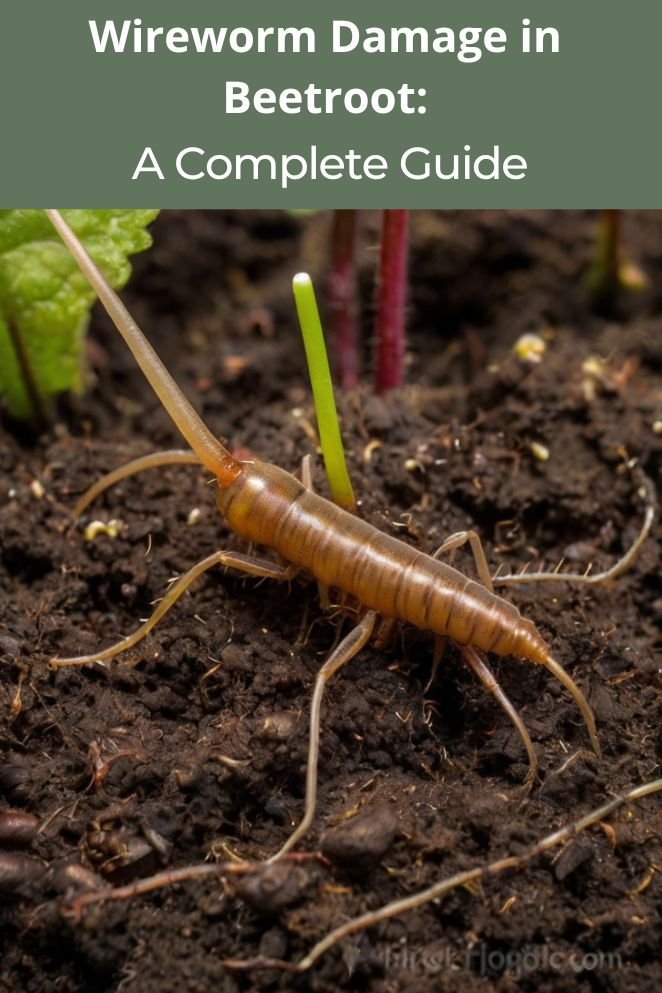
Wireworms are a real headache for beetroot growers.
These sneaky underground pests chew through roots and can wreck your harvest fast.
If you grow beets, you need to know how to spot the damage, prevent infestations, and keep your soil in check—otherwise, you’re just feeding wireworms instead of your customers.
Identifying Wireworm Damage in Beetroot
Wireworms don’t mess around—they start attacking your beets before they even sprout.
If you’re seeing patchy germination or wilting seedlings, it might not be bad seed or weather.
It could be wireworms chewing through seeds and young roots underground.
Early signs (seed + seedling stage)
First clue? Seeds don’t sprout—or they take forever. That’s wireworms feeding on them before they get a chance.
If seedlings do come up, check the stems just under the soil.
Wireworms make tiny round holes that turn black fast. The plant wilts, then dies.
You’ll see random gaps in your rows, not full-field damage.
Later damage (root stage)
In mature plants, wireworms tunnel deep into the beetroot.
You’ll spot winding holes and cavities in the root—think tiny mining operations.
These open the door to rot, bacteria, and fungus.
Even mild damage shortens shelf life and makes your crop hard to sell.
Where it shows up
Wireworm damage is usually patchy—not spread across the whole field.
If you see random dead zones, especially in spots that were grassland or have lots of organic matter, that’s a red flag.
Those are their favorite hangouts.

Lifecycle and Behavior: Key to Effective Management
If you want to beat wireworms, you need to know their routine.
These pests play the long game.
When they show up
Adult click beetles (the ones that lay wireworm eggs) hang out underground from fall to early spring.
Come May and June, the females lay eggs just below the soil surface—right when you’re planting your beets.
That’s your window to act.
Why they’re so hard to kill
Wireworms don’t just show up for a season and leave.
Their larvae stick around in the soil for 2–5 years. They grow slow but steady—and once they’re in, they’re hard to get rid of.
They’re most active in spring and fall when soil temps are mild.
But in summer heat or winter cold, they go deeper into the soil, where treatments can’t touch them.
So if you’re spraying in July and not seeing results, that’s why—they’re hiding out like it’s witness protection.
Prevention Strategies: Building Long-Term Success
Stopping wireworms before they get comfy in your field is way easier than trying to fight them later.
Here’s how to keep them from setting up shop in your beets.
Rotate smarter
Don’t grow beets after beets. Rotate with crops wireworms don’t care for—like brassicas, legumes, or some grasses.
That breaks their life cycle and helps shrink their population over time.
And be picky about your fields. If a field was grassland or pasture recently, wireworms are probably already there.
Skip planting beets in those spots for a few years if you can.
Manage the soil
Wireworms hate being disturbed. If you know they’re around, fallow the field during summer and till it regularly.
Use a springtooth or disk—you’re basically flushing them out and letting birds, bugs, and sun do the dirty work.
Also, wireworms love wet, compacted soil.
So keep your beds well-drained, well-structured, and balanced in pH and nutrients.
Healthy soil = stronger plants that can take a few bites and keep going..
Monitor like a pro
Don’t guess—check.
- Bait stations: Bury cut-up potatoes or soaked wheat kernels around the field in early spring. Come back in a few days and see if they’re crawling with larvae.
- Soil sampling: Dig in a few different spots—especially where you’ve had problems before. Look for wireworms directly.
- Watch your stand: If germination is patchy or seedlings are wilting randomly, check below the surface. Wireworms often show up before anything else does.

Treatment and Management Options
If wireworms still show up after all your prep, don’t panic—but you’ll need a plan.
Once they’re in the soil, treatment options are limited, especially for beets. Here’s what actually works (and what doesn’t).
Chemical options
There’s no rescue spray once beets are up. No magic fix post-emergence.
So if you’re going the chemical route, timing is everything.
- Treat the soil before planting
- Use seed treatments—but only on rotation crops (like cereals), since beet seeds don’t have many approved options
- Only treat if monitoring says it’s worth it—don’t guess
This is why prevention matters so much. If you miss that window, you’re just feeding wireworms.
Biological control
Chickens: Seriously—if you can run chickens through a bed before planting, they’ll scratch up and eat the larvae
- Predators: Ground beetles, spiders, and other bugs help keep wireworm numbers down—give them habitat
- Nematodes: Some beneficial nematodes (like Steinernema species) attack wireworms in the soil
- Potato traps: Bury slices of raw potato—wireworms go for them. Pull them up and toss the worms
Integrated management strategies
The best way to stay ahead is to mix strategies:
- Scout your fields and check bait traps
- Rotate with smart crops
- Prep soil well and keep it healthy
- Only treat when necessary
- Protect helpful bugs—don’t go scorched earth
Wireworms are stubborn. But with layered tactics and good timing, you can keep them in check—and save your beet harvest from looking like Swiss cheese.
Recovery and Replanting Considerations
If wireworms wipe out your seedlings, sometimes replanting is your best shot—but it’s not always a sure thing.
Before you rush to re-seed, take a step back and ask:
- How bad was it? If large chunks of the field are toast, it might be worth replanting. If it’s just a few patches, it might not pay off.
- Are the worms still active? Don’t plant into the same problem. Check bait traps or dig a few test spots. If they’re still chewing, you’ll just lose round two.
- How’s the soil? Wet, compacted, or cold soil will just slow things down again. Replanting only works if the soil’s ready.
- Can you replant in time? If it’s too late in the season, your new crop might not mature in time. Sometimes switching to a quicker-growing backup crop makes more sense.
- Is it worth the cost? Factor in seed, fuel, labor, and lost time. Some seasons it’s better to cut losses and focus on prepping for the next round.

Wireworms in Beets: Plan Ahead or Pay Later
Wireworms are tough to get rid of once they’re in your field.
That’s why smart growers focus on long-term prevention—crop rotation, soil care, and regular scouting.
There’s no quick fix. Managing wireworms takes consistency and timing.
Skip the guesswork, use bait traps, prep your soil, and don’t rely on rescue sprays—they rarely work once damage is done.
Whether you’re farming for profit or just growing beets for market, the strategy’s the same: know your field, stay ahead of the pest, and treat wireworm control like a season-long job—not a one-time chore.



